Dayton, Ohio, Hgh State Clinic, Hgh Injections, Hrt Doctors
Dayton, Ohio Blood Testing Facilities
 Represents a LabCorp blood testing facility
Represents a LabCorp blood testing facility Represents a Quest Diagnostics blood testing facility
Represents a Quest Diagnostics blood testing facility
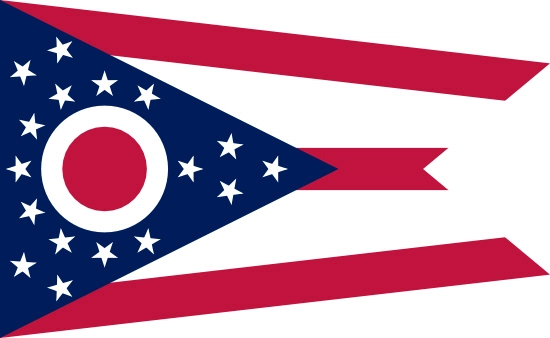
Nearby Labcorp Blood Testing facilities:
- Labcorp Center Distance: 0 m, 1 Elizabeth Pl Ste 250, Dayton, Montgomery County, OH, 45408
- Labcorp Center Distance: 7 m, 3464 Pentagon Park Blvd Ste E, Beavercreek, Greene County, OH, 45431
- Labcorp Center Distance: 8 m, 415 Byers Rd Ste 200, Miamisburg, Montgomery County, OH, 45342
- Labcorp Center Distance: 14 m, 7774 Dayton Springfield Rd, Fairborn, Clark County, OH, 45324
- Labcorp Center Distance: 20 m, 1036 S. Verity Pkwy, Middletown, Butler County, OH, 45044
- Labcorp Center Distance: 23 m, 140 West Main St. Suite 203, Springfield, Clark County, OH, 45502
- Labcorp Center Distance: 29 m, 721 Reading Rd, Mason, Warren County, OH, 45040
- Labcorp Center Distance: 31 m, 903 Nw Washington Blvd Ste C, Hamilton, Butler County, OH, 45013
- Labcorp Center Distance: 34 m, 780 Nilles Rd B, Fairfield, Butler County, OH, 45014
- Labcorp Center Distance: 35 m, 2740 Mack Rd, Fairfield, Butler County, OH, 45014
- Labcorp Center Distance: 36 m, 10475 Reading Rd Ste 306, Evandale, Hamilton County, OH, 45241
- Labcorp Center Distance: 38 m, 9030 Montgomery Rd, Cincinnati, Hamilton County, OH, 45242
- Labcorp Center Distance: 40 m, 83 Powhatton Dr, Milford, Clermont County, OH, 45150
- Labcorp Center Distance: 45 m, 4767 N Bend Rd, Cincinnati, Hamilton County, OH, 45211
- Labcorp Center Distance: 47 m, 500 Ohio Pike, Cincinnati, Clermont County, OH, 45255
- Labcorp Center Distance: 48 m, 1275 N High St, Hillsboro, Highland County, OH, 45133
- Labcorp Center Distance: 54 m, 500 Thomas More Pkwy 8, Crestview Hills, Kenton County, KY, 41017
- Labcorp Center Distance: 57 m, 4998 W Broad St Ste 112, Columbus, Franklin County, OH, 43228
- Labcorp Center Distance: 58 m, 4461 Broadway Ste 300, Grove City, Franklin County, OH, 43123
- Labcorp Center Distance: 59 m, 5920 Wilcox Pl Ste F, Dublin, Franklin County, OH, 43016
- Labcorp Center Distance: 63 m, 2200 Forest Ridge Pkwy Ste 310, New Castle, Henry County, IN, 47362
- Labcorp Center Distance: 64 m, 4830 Knightsbridge Blvd Ste K, Columbus, Franklin County, OH, 43214
- Labcorp Center Distance: 67 m, 116 Morris Rd, Circleville, Pickaway County, OH, 43113
- Labcorp Center Distance: 69 m, 5888 Cleveland Ave, Columbus, Franklin County, OH, 43231
- Labcorp Center Distance: 70 m, 56 Westerview Drive, Westerville, Franklin County, OH, 43081
- Labcorp Center Distance: 71 m, 800 S Tillotson, Muncie, Delaware County, IN, 47304
- Labcorp Center Distance: 73 m, 941 E Johnstown Rd, Gahanna, Franklin County, OH, 43230
- Labcorp Center Distance: 76 m, 664 N Hill Rd, Pickerington, Fairfield County, OH, 43147
- Labcorp Center Distance: 80 m, 910 Kenton Station Drive, Maysville, Mason County, KY, 41056
- Labcorp Center Distance: 82 m, 955 High St, Decatur, Adams County, IN, 46733
- Labcorp Center Distance: 93 m, 95 S Terrace Ave, Newark, Licking County, OH, 43055
- Labcorp Center Distance: 96 m, 1127 N Western Ave, Marion, Grant County, IN, 46952
- Labcorp Center Distance: 98 m, 7914 N Shadeland Suite 150, Indianapolis, Marion County, IN, 46250
Nearby Quest Blood Testing facilities:
- Quest Center Distance: 0 m, 1 Elizabeth Pl, Dayton, Montgomery County, OH, 45417-3445
- Quest Center Distance: 1 m, 1 Wyoming Street, Dayton, Montgomery County, OH, 45409-2722
- Quest Center Distance: 4 m, 540 Lincoln Park Drive, Kettering, Montgomery County, OH, 45429-6403
- Quest Center Distance: 6 m, 725 University Boulevard, Dayton, Montgomery County, OH, 45435-0001
- Quest Center Distance: 7 m, 2601 Commons Blvd, Beavercreek, Greene County, OH, 45431-3831
- Quest Center Distance: 8 m, 900 S. Dixie Drive, Vandalia, Montgomery County, OH, 45377-2657
- Quest Center Distance: 10 m, 1836 Commerce Center Blvd, Fairborn, Greene County, OH, 45324-6337
- Quest Center Distance: 12 m, 630 N Main St, Springboro, Warren County, OH, 45066-7519
- Quest Center Distance: 14 m, 1214 N Monroe Dr, Xenia, Greene County, OH, 45385-1622
- Quest Center Distance: 19 m, 62 N Breiel Blvd, Middletown, Butler County, OH, 45042-3804
- Quest Center Distance: 25 m, 2355 Derr Rd, Springfield, Clark County, OH, 45503-2439
- Quest Center Distance: 29 m, 7608 Cox Ln, West Chester, Butler County, OH, 45069-6547
- Quest Center Distance: 31 m, 1426 Main St, Hamilton, Butler County, OH, 45013-1004
- Quest Center Distance: 32 m, 9313 S Mason Montgomery Rd, Mason, Warren County, OH, 45040-8826
- Quest Center Distance: 34 m, 5130 Pleasant Ave, Fairfield, Butler County, OH, 45014-2611
- Quest Center Distance: 37 m, 816 Dillon Drive, Richmond, Wayne County, IN, 47374-1911
- Quest Center Distance: 39 m, 8250 Kenwood Crossing Way, Cincinnati, Hamilton County, OH, 45236-3670
- Quest Center Distance: 42 m, 2475 W Galbraith Rd, Cincinnati, Hamilton County, OH, 45239-4369
- Quest Center Distance: 48 m, 7235 Beechmont Ave, Cincinnati, Hamilton County, OH, 45230-4116
- Quest Center Distance: 58 m, 50 Old Village Rd, Columbus, Franklin County, OH, 43228-1538
- Quest Center Distance: 60 m, 5130 Bradenton Ave, Dublin, Franklin County, OH, 43017-7557
- Quest Center Distance: 74 m, 99 N Brice Rd North, Columbus, Franklin County, OH, 43213-6510
- Quest Center Distance: 79 m, 1069 Delaware Ave, Marion, Marion County, OH, 43302-6459
- Quest Center Distance: 96 m, 9669 146Th Street, Noblesville, Hamilton County, IN, 46060-5005
- Quest Center Distance: 98 m, 2040 N Shadeland Ave, Indianapolis, Marion County, IN, 46219-1711
Ohio Hormone Replacement Therapy Services
The physicians and clinicians at the Conscious Evolution Institute are board certified and clinically experienced in the diagnosis and treatment of medical conditions associated with hormone imbalance. Our doctors know which treatments work, and which don't, and combine effective medical treatments with in-depth diet and lifestyle counseling in order to maximize the effects of therapy in order to help you feel younger than you have in years!
Bio-Identical HGH Deficiency Treatments in Ohio
Are you interested in Human Growth Hormone and don't know where to turn for effective treatment? The Conscious Evolution Institute specializes in HGH Hormone Restoration, and can help you learn whether Human Growth Hormone Injections are right for you. HGH is a vitally important metabolic hormone, and as we get older, we produce less and less of it. Symptoms of HGH Deficiency include loss of physical exercise capacity, fatigue, depression, and poor sleep, among many others.
Many people think that HGH is illegal for adults, but for men and women with Human Growth Hormone Deficiency (also known as Somatopause), HGH Replacement may be the most efficient way to help you restore energy and vitality to your life. We also provide Sermorelin Acetate Injections, which have been proven to be effective at naturally restoring endogenous HGH Secretion
Low-T Therapy Options for the State of Ohio
Testosterone Deficiency is widely recognized as a highly disruptive disorder which contributes greatly to mortality risk and loss of quality of life. If you are a man, thirty years or older, that has noticed some significant changes in your physiological health, including unexplained changes in BMI, loss of muscle mass, fatigue, or depression, combined with sexual issues such as loss of sex drive and erectile dysfunction, the Conscious Evolution Institute can help you get the Testosterone Replacement Therapy that can restore your hormone balance and improve your health and your sex life!
HCG Weight Loss Therapy for the Citizens of Ohio
Obesity is reaching epidemic levels in the United States, and many men and women have significant trouble losing weight and keeping it off. They have the desire to change, but are having trouble building up the willpower.
HCG Therapy has helped hundreds of thousands across America lose weight quickly and efficiently, and it can help you too. HCG Injections, when combined with a specialized diet plan, can burn as much as five pounds per week, without draining you of the energy that you need to survive the perils of everyday life. HCG is special, because it can actually relieve the feelings of hunger associated with a strict diet, helping you stick to the diet and lose weight with a smile!
Major Cities in Ohio
Columbus
Columbus is the capital city of Ohio, as well as being the city with the highest population. Although it is the largest city in the state, it represents the third largest metropolitan area, as it is smaller than the metros of both Cincinnati and Cleveland. The city of Columbus is named after Christopher Columbus, one of the first European explorers to discover North America.
Columbus has a large and diverse economy, and is considered one of the best cities for business in the United States. Columbus even survived the Great Recession largely unscathed, because of this economic diversity and its importance to the national economy. Columbus is the home of Ohio State University, as well as the MLS team the Columbus Crew.
Cleveland
Cleveland is the second largest city in Ohio, but is the largest metro population. Cleveland is one of many cities which represent the Rust Belt in the Midwest. Cleveland garnered the nick name, the Rock and Roll Capital of the World, because of its vital importance to the early Rock and Roll scene. The Rock and Roll Hall of Fame is also located in the city.
Cleveland is an important city for professional sports, with a number of teams, including the NFL Cleveland Browns, the NBA Cleveland Cavaliers, and the MLB Cleveland Indians. Cleveland has a complex economy with significant jobs generated by biomedical engineering, healthcare, banking, and manufacturing. In spite of the decline of manufacturing in many other Midwestern Automotive cities, Cleveland remains strong.
Cincinnati
Cincinnati is the third largest city in Kentucky and the second largest metro area, located on the border of Ohio and Kentucky, along the Ohio River. Cincinnati was named after the Society of the Cincinnati, an order founded to preserve the values and kinship of military officers in the American Revolution.
Cincinnati, like other major cities in Ohio, has a strong and varied economy, and is the headquarters of a number of major companies in the United States, including Macy's Inc., the Kroger Company, and Procter and Gamble. The University of Cincinnati is located in the city, and the city is home to the MLB Cincinnati Reds and the NFL Bengals.
Toledo
Toledo, Ohio is the largest city in western Ohio, and is the fourth largest city in the state. Toledo is often referred to as The Glass City, because historically, its largest industry has been the manufacture and distribution of glass products. Toledo used to be a strong presence in the automotive industry, but in recent decades have had to move on as a result of the declining domestic automotive manufacturing economy.
Toledo has a number of amateur sports teams, but the city's most significant contribution to athletics is the Inverness Golf Club, which hosts a number of USGA events annually.
Akron
Akron is located in the northeast Ohio, about forty miles south of Cleveland. Today, Akron is probably most famous as the hometown of Lebron James, but the city has historically been a very important economic force, the genesis of a number of different industries, most notably the rubber and tire industry. The city is still referred to as The Rubber Capital of the World, but the city has also become a center for high-tech industry.
The University of Akron is located in the city, and the most important athletic event hosted in the city is the PGA Championship, at the Firestone Country Club. Firestone also has an annual PGA Event: the WGC-Bridgestone Invitational.
All About Dayton, Ohio Geographic Area
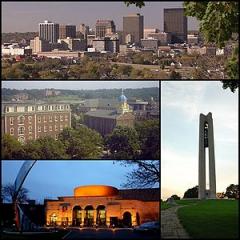

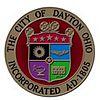
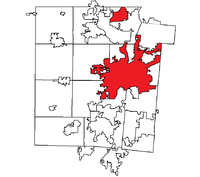
Dayton ( /Ëndeɪtn/) is the 6th largest city in the U.S. state of Ohio and is the county seat of Montgomery County. At the 2010 census, the population was 141,527; the Dayton metropolitan area had 841,502 residents, making it the fourth largest metropolitan area in Ohio and the 61st largest in the United States. The Dayton-Springfield-Greenville Combined Statistical Area had a population of 1,072,891 in 2010 and is the 43rd largest in the United States. Dayton is situated within the Miami Valley region of Ohio just north of the Cincinnati aeNorthern Kentucky metropolitan area.
/Ëndeɪtn/) is the 6th largest city in the U.S. state of Ohio and is the county seat of Montgomery County. At the 2010 census, the population was 141,527; the Dayton metropolitan area had 841,502 residents, making it the fourth largest metropolitan area in Ohio and the 61st largest in the United States. The Dayton-Springfield-Greenville Combined Statistical Area had a population of 1,072,891 in 2010 and is the 43rd largest in the United States. Dayton is situated within the Miami Valley region of Ohio just north of the Cincinnati aeNorthern Kentucky metropolitan area.
Ohio's borders are within 500 miles (805 km) of roughly 60% of the country's population and manufacturing infrastructure making the Dayton area a logistical centroid for manufacturers, suppliers, and shippers. Dayton also plays host to significant research and development in fields like industrial, aeronautical, and astronautical engineering that have led to many technological innovations. Much of this innovation is due in part to Wright-Patterson Air Force Base and its place within the community. With the decline of heavy manufacturing, Dayton's businesses have diversified into a service economy that includes insurance and legal sectors as well as healthcare and government sectors.
Other than defense and aerospace, healthcare accounts for much of the Dayton area's economy. Hospitals in the Greater Dayton area have an estimated combined employment of nearly 32,000, a yearly economic impact of $6.8 billion. It is estimated that Premier Health Partners, a hospital network, contributes more than $2 billion a year to the region through operating, employment, and capital expenditures. In 2011, Dayton was rated the #3 city in the nation out of the top 50 cities in the United States by HealthGrades for excellence in health care. Many hospitals in the Dayton area are consistently ranked by Forbes, U.S. News & World Report, and HealthGrades for clinical excellence.
Dayton is also noted for its association with aviation; the city is home to the National Museum of the United States Air Force. Orville Wright, poet Paul Laurence Dunbar, and entrepreneur John H. Patterson were born in Dayton. Dayton is also known for its many patents, inventions, and inventors that have come from the area, most notable being the Wright Brothers' invention of powered flight. In 2008, 2009, and 2010, Site Selection magazine ranked Dayton the #1 mid sized metropolitan area in the nation for economic development. Also in 2010, Dayton was named one of the best places in the United States for college graduates to find a job.
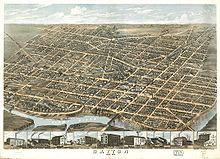
Dayton was founded on April 1, 1796, seven years before the admission of Ohio to the Union in early 1803, by a group of 12 settlers known as "The Thompson Party." They traveled in March from Cincinnati up the Great Miami River by pirogue and landed at what is now St. Clair Street, where they found two small camps of Native Americans. Among the settlers was Benjamin Van Cleve, whose memoirs provide insights into the history of the Ohio Valley. Two other groups who were travelling overland arrived several days later.
In 1797, Daniel C. Cooper had laid out the Mad River Road, the first overland connection between Cincinnati, Ohio, and Dayton, opening the "Mad River Country" at Dayton and the upper Miami Valley to settlement.
The city was incorporated in 1805 and was named after Jonathan Dayton, who owned the land. Dayton had been a captain in the American Revolutionary War and was a signer of the U.S. Constitution. By 1827, construction on the Dayton-Cincinnati canal began as a way to better transport goods from Dayton to Cincinnati. The canal provided the main source of growth for Dayton at the time.
Historically, Dayton has been the site for many patents and inventions since the 1870s. Famous inventors such as the Wright Brothers, who invented the practical airplane, and Charles F. Kettering, who had numerous inventions, also came from Dayton. According to the National Park Service, citing information from the U.S. Patent Office, Dayton had more granted patents per capita than any other U.S. city in 1890 and ranked fifth in the nation as early as 1870.
The 1890s brought several key persons to the forefront of Dayton's historical achievements. The first, Paul Laurence Dunbar an African American poet, began his most famous works in the 1890s and is an integral part of Dayton's history. Dunbar became a nationally recognized poet. The second were the Wright Brothers who were credited for inventing the world's first successful airplane and founding the Wright Cycle Company.
In 1884, The National Cash Register Company was founded by John Henry Patterson which manufactured the first cash registers in existence. The company played a crucial role in the success and shaping of Dayton as a manufacturing center and in the livelihood of Dayton residents as a source of employment and tax revenue. In 1906, Charles F. Kettering introduced the first electric cash register to the company. This helped to further increase the presence and production of NCR. After the Great Dayton Flood, John Patterson donated nearly one million dollars to help with cleanup and rescue efforts. This move helped to further draw the importance of the company to Dayton. NCR was also known for its code-breaking machines, including the American Navy bombe designed by Joseph Desch which helped crack the Enigma machine cipher.
The catastrophic Great Dayton Flood of March 1913 severely affected much of the city, stimulated the growth of suburban communities outside central Dayton in areas lying further from the Miami River and on higher ground, and led to the establishment of the Miami Conservancy District in 1914. The flood remains an event of note in popular memory and local histories. The high waters damaged some of the Wright Brothers' glass plate photographic negatives of their glider flights at Kitty Hawk and power flights over Huffman Prairie near Dayton.
During World War II, Dayton, like many other American cities, was heavily involved in the war effort. Residential neighborhoods in Dayton and in nearby Oakwood hosted the Dayton Project, in which the Monsanto Chemical Company developed methods to industrially produce polonium for use in the triggers of early atomic bombs, including those dropped by the United States on Hiroshima and Nagasaki, Japan. Because of Dayton's manufacturing boom to support war efforts, housing in the Dayton area was in extremely high demand. In an attempt for the region to keep up, emergency housing was put into place because of a lack of dwellings in the region. Many of these dwellings that were meant to be temporary are still inhabited today.
Between the 1940s and the 1970s, significant suburban growth began to take place. Along with the implementation of the Interstate Highway System, more than 1.8 million homes were built in Montgomery County alone between 1950 and 1960. Many of these homes were built in neighboring suburbs as growth in the city proper of Dayton slowed. Despite Dayton's slowed growth, many of Dayton's high-rise buildings were also constructed during this period.
From the 1980s to recent times, Dayton's population has declined due to the drop in heavy manufacturing and national economic woes. Despite this, Dayton has diversified its workforce from manufacturing to healthcare and defense. It is recognized as Ohio's aerospace hub.
The 2000s brought revitalization to Dayton's urban core. Fifth Third Field, home of the Dayton Dragons, was built in 2000. The stadium and minor league baseball team have been an important part of Dayton's culture. The Dragons have the nation's longest sellout streak in all professional sports, and they remain very popular in the region. The Schuster Center performing arts theater, which opened in 2003, provides a new arts venue for the city. Miami Valley Hospital added a 12-story patient tower. Five Rivers MetroParks expanded and added a bike hub, as well as an outdoor entertainment venue for concerts downtown.
In 2010, the city introduced the Greater Downtown Dayton Plan. It focuses on job creation and retention, infrastructure improvements, housing, recreation, and collaboration. The plan is to be implemented through the year 2020.
The Dayton Agreement, a peace accord between the parties to the hostilities of the conflict in Bosnia-Herzegovina and the former Yugoslavia, was negotiated at Wright-Patterson Air Force Base. Negotiations took place from November 1, 1995, to November 21, 1995, at Wright-Patterson Air Force Base, near to Fairborn, Ohio.
Richard Holbrooke wrote about this event in his memoirs:
There was also a real Dayton out there, a charming Ohio city, famous as the birthplace of the Wright Brothers. Its citizens energized us from the outset. Unlike the population of, say, New York, Geneva or Washington, which would scarcely notice another conference, Daytonians were proud to be part of history. Large signs at the commercial airport hailed Dayton as the "temporary center of international peace". The local newspapers and television stations covered the story from every angle, drawing the people deeper into the proceedings. When we ventured into a restaurant or a shopping center downtown, people crowded around, saying that they were praying for us. Warren Christopher was given at least one standing ovation in a restaurant. Families on the air base placed "candles of peace" in their front windows, and people gathered in peace vigils outside the base. One day they formed a "peace chain", although it was not large enough to surround the sprawling eight-thousand-acre base. Ohio's famous ethnic diversity was on display.
Dayton's primary nickname is the "Gem City." The origin of the name appears to relate either to a well-known racehorse named "Gem" that hailed from Dayton, or from descriptions of the city likening it to a gem. The most likely origin appears to be an 1845 article in the Cincinnati Daily Chronicle by an author writing with the byline "T":
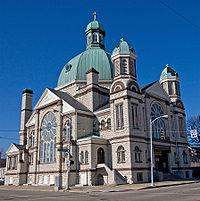
Paul Laurence Dunbar (1872 ae1906) referred to the nickname in his poem, "Toast to Dayton", which contains this stanza:
Another explanation for the nickname Gem notes that Dayton's sister city to the south, Cincinnati, is known as the "Queen City." Dayton is a gem in the queen's crown.
The city was advertised as "The Gem City, the Cleanest City in America" in the 1950s, 60s and into the 70s. The phrase was often seen on public trash cans, and other places throughout the city during this time period. Dayton has a consistent street cleaning schedule: each morning, street cleaners sweep downtown Dayton of any trash from the previous day.
Ohio's nickname "Birthplace of Aviation" is related to Dayton being the hometown of the Wright Brothers. In their bicycle shop in Dayton, the Wrights developed the principles of aerodynamics, and designed and constructed a number of gliders and portions of their first airplane. After their first manned flights in Kitty Hawk, North Carolina, which had been chosen due to its ideal weather and climate conditions, the Wrights returned to Dayton and continued testing at nearby Huffman Prairie.
Dayton's climate features hot, muggy summers and cold, dry winters, and is either classified as a humid subtropical climate (Koppen Cfa), using the na3 °C (26.6 °F) isotherm of the original Koppen scheme, or a humid continental climate (Koppen Dfa), using the 0 °C (32 °F) isotherm preferred by some climatologists. It should be noted that the table presented above is from Dayton International Airport, 10 miles (16 km) to the north of downtown Dayton, which lies within the Miami Valley, and thus temperatures in the former location are often cooler than in downtown.
At the airport, Monthly mean temperatures range from 26.4 °F ( na3.1 °C) in January to 74.3 °F (23.5 °C) in July. The highest temperature ever recorded in Dayton was 108 °F (42 °C) in July 1901, and the coldest was na28 °F ( na33 °C) in February 1899.
Dayton is subject to severe weather typical of the Midwestern United States. Tornadoes are possible from the spring to the fall. Floods, blizzards and severe thunderstorms can also occur from time to time.
The population of Dayton has been declining since the 1970s, as can be observed from portrayal of historical population data. This is in part due to the slowdown of manufacturing in the region and the growth of Dayton's affluent suburbs including Oakwood, Englewood, Beavercreek, Springboro, Miamisburg, Kettering, and Centerville. The city's most populous ethnic group, white, declined from 78.1% in 1960 to 51.7% by 2010.
As of the census of 2010, there were 141,527 people, 58,404 households, and 31,064 families residing in the city. The population density was 2499.2 people per square mile (964.9/km ²). There were 74,065 housing units at an average density of 1307.9 per square mile (505.0/km ²). The racial makeup of the city was 51.7% White, 42.9% Black, 0.3% Native American, 0.9% Asian,
There were 58,404 households out of which 24.0% had children under the age of 18 living with them, 25.9% were married couples living together, 21.4% had a female householder with no husband present, 5.9% had a male householder with no wife present, and 46.8% were non-families. 38.8% of all households were made up of individuals and 22.7% had someone living alone who was 65 years of age or older. The average household size was 2.26 and the average family size was 3.03.
As of the 2000 census, the median income for a household in the city was $27,523, and the median income for a family was $34,978. Males had a median income of $30,816 versus $24,937 for females. The per capita income for the city was $34,724. About 18.2% of families and 23.0% of the population were below the poverty line, including 32.0% of those under age 18 and 15.3% of those age 65 or over.
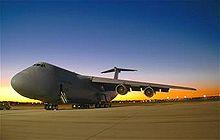
Dayton's economy is relatively diversified and vital to the overall economy of the state of Ohio. In 2008 and 2009, Site Selection magazine ranked Dayton the #1 medium sized metropolitan area in the U.S. for economic development. Also in 2010, according to Bloomberg Businessweek Dayton was one of the best places in the U.S. for college graduates to find a job. Dayton is also among the top 100 metropolitan areas in the United States exports and export related jobs by the Brookings Institution. Dayton ranked number 16 out of the top 100 metropolitan areas for exports and number 14 in export related jobs with 44,133 Dayton employees related to exports. The report placed the value of exports from Dayton at $4.7 billion, ranking the metropolitan area at number 56 for the statistic. The Dayton Metropolitan Statistical Area ranks 4th in Ohio's Gross Domestic Product with a 2008 industry total of $33.78 billion. Additionally, Dayton ranks 3rd among 11 major metropolitan areas in Ohio for exports to foreign countries. In 2008, products and services with value of more than $4.5 billion were exported from the Dayton area. Moody's Investment Services revised Dayton's bond rating from A1 to the stronger rating of Aa2 as part of its global recalibration process. Standard and Poor's upgraded Dayton's rating from A+ to AA- in the summer of 2009.
Companies such as Reynolds and Reynolds, CareSource, DPL, LexisNexis, Kettering Health Network, Premier Health Partners, and Standard Register have their headquarters in Dayton. It is the former home of the Speedwell Motor Car Company and the Mead Paper Company before it became MeadWestvaco. Behr Dayton Thermal Products LLC is also located in Dayton. The Dayton Development Coalition is attempting to leverage the regions large water capacity, estimated to be 1.5 trillion gallons of renewable water aquifers, to attract new businesses.
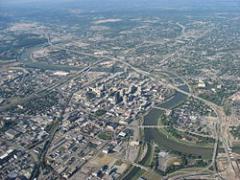
The Dayton region gave birth to aviation and is known for its high concentration of aerospace and aviation technology. In 2009, Governor Ted Strickland designated Dayton as Ohio's aerospace innovation hub, the first such technology hub in the state. Two major United States research and development organizations have leveraged Dayton's historical leadership in aviation and maintain their headquarters in the area: The National Air and Space Intelligence Center (NASIC) and the Air Force Research Laboratory (AFRL). NASIC is the U.S. military's primary producer of intelligence on foreign air and space forces, weapons and systems, while the AFRL provides leading-edge warfighting capabilities to keep the United States air, space and cyberspace forces the world's best. Both have their headquarters at Wright-Patterson Air Force Base. Wright-Patterson Air Force Base is one of the largest air base wings in the Air Force. Its over 27,400 employees and 68 tenant units generated a Total Economic Impact in the Dayton area of $5.1 billion in its 2009 fiscal year. In addition, state officials are working to make the Dayton region a hub and a leader for UAV research and manufacturing.
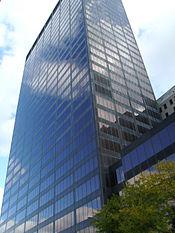
Several research organizations support NASIC, AFRL and the Dayton community. The Advanced Technical Intelligence Center, is a confederation of government, academic and industry partners that leverage advanced technical intelligence expertise. daytaOhio is a non-profit organization based at Wright State University in Dayton. The University of Dayton Research Institute (UDRI), is led by the University of Dayton. In 2004 and 2005, UDRI was ranked #2 in the nation by the National Science Foundation in federal and industry-funded materials research. The Cognitive Technologies Division (CTD) of Applied Research Associates, Inc., which carries out human-centered research and design, is headquartered in the Dayton suburb of Fairborn. The city of Dayton has started Tech Town, a development project intended to attract technology-based firms and revitalize the downtown area. Tech Town is home to the world's first RFID business incubator. The University of Dayton-led Institute for Development & Commercialization of Sensor Technologies (IDCAST) at TechTown is a world-class center for excellence in remote sensing and sensing technology. It is one of Dayton's technology business incubators housed in The Entrepreneurs Center building.
The NCR Corporation (originally named the National Cash Register Corporation), which was founded and headquartered in Dayton for over 125 years, was a major innovator in computer technology. The 455,000-square-foot (42,300 m2) building complex that formerly housed NCR's headquarters has been adapted for use by the UDRI.
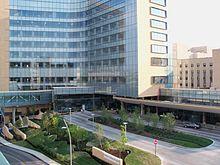
The Kettering Health Network and Premier Health Partners have a major role on the Dayton area's economy. Hospitals in the Greater Dayton area have an estimated combined employment of nearly 32,000, a yearly economic impact of $6.8 billion. Thomson Reuters rated the Kettering Health Network as one of the top 10 hospital networks for clinical excellence in the United States. In addition, several Dayton area hospitals consistently earn top national ranking and recognition including the U.S. News & World Report's list of "America's Best Hospitals" as well as many of HealthGrades top ratings. The most notable hospitals are Miami Valley Hospital and Kettering Medical Center. In 2011, the Dayton area was rated number three in the nation out of the top 50 cities in the United States by HealthGrades for excellence in healthcare. Also in 2011, Dayton was ranked the fourth best in the nation for emergency medicine care.
Several key institutes and centers for health care exist in the Dayton region. The Center for Tissue Regeneration and Engineering at Dayton is a center that focuses on the science and development of human tissue regeneration. The National Center for Medical Readiness (NCMR) is also located in the Dayton area. The center includes Calamityville which is a state-of-the art disaster training facility. It is conservatively estimated that over a period of five years, Calamityville will have a regional economic impact of $374 million. Also, the Neurological Institute at Miami Valley Hospital is an institute focused on the diagnosis, treatment, and research of neurological disorders.
According to Dayton's 2010 Comprehensive Annual Financial Report, the top employers in the city proper are:

Unlike many midwestern cities of its age, Dayton has very broad and straight downtown streets (generally two or three full lanes in each direction), facilitating access to the downtown even after the automobile became popular. The main reason for the broad streets was that Dayton was a marketing and shipping center from its beginning: streets were broad to enable wagons drawn by teams of three to four pairs of oxen to turn around. In addition, some of today's streets were once barge canals flanked by draw-paths.
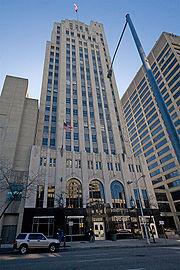
A courthouse building was constructed in downtown Dayton in 1888 to supplement Dayton's original Neoclassical courthouse, which still stands. This second, "new" courthouse has since been replaced with new facilities as well as a park. The Old Court House has been a favored political campaign stop. On September 17, 1859, future president Abraham Lincoln delivered an address on the steps of the building. Eight other presidents have visited the courthouse, either as presidents or during presidential campaigns. They include Andrew Johnson, James Garfield, John F. Kennedy, Lyndon B. Johnson, Richard Nixon, Gerald Ford, Ronald Reagan, and Bill Clinton.
In 2009, the CareSource Management Group finished construction of a $55 million corporate headquarters in downtown Dayton. The 300,000-square-foot (28,000 m2), 10-story building marks downtown's first new office tower in more than a decade.
The two tallest buildings of the Dayton skyline are the Kettering Tower at 408 ft (124 m) and the KeyBank Tower at 385 ft (117 m). Kettering Tower was originally Winters Tower, the headquarters of Winters Bank. The building was renamed after Virginia Kettering when Winters was merged into BankOne. KeyBank Tower was formerly known as the MeadWestvaco Tower before KeyBank gained naming rights to the building in 2008.
Dayton's ten historic neighborhoods ae Oregon District, Wright Dunbar, Dayton View, Grafton Hill, McPherson Town, Webster Station, Huffman, Kenilworth, St. Anne's Hill, and South Park ae feature mostly single-family houses and mansions in the Neoclassical, Jacobethan, Tudor Revival, English Gothic, Chateauesque, Craftsman, Queen Anne, Georgian Revival, Colonial Revival, Renaissance Revival Architecture, Shingle Style Architecture, Prairie, Mission Revival, Eastlake/Italianate, American Foursquare, and Federal styles of architecture. Downtown Dayton is also a large area that encompasses several neighborhoods itself, and has seen a recent uplift and revival.
Dayton's suburbs with a population of 10,000 or more include Beavercreek, Centerville, Clayton, Englewood, Fairborn, Harrison Township, Huber Heights, Kettering, Miami Township, Miamisburg, Oakwood, Riverside, Springboro (partial), Trotwood, Vandalia, Washington Township, West Carrollton, and Xenia.
The Dayton Region ranked within the top 10% in the nation out of 373 metropolitan areas in arts and culture. In 2012, Dayton ranked #2 in the country as an arts destination ranking higher than larger cities such as Atlanta, St. Louis, and Cincinnati. Dayton is the home of the Dayton Art Institute (see below).
The Benjamin and Marian Schuster Performing Arts Center in downtown Dayton, is a world-class performing arts center and the home venue of the Dayton Philharmonic Orchestra, Dayton Opera, and the Dayton Ballet. In addition to Philharmonic and Opera performances, the Schuster Center hosts concerts, lectures, traveling Broadway shows, and is a popular spot for weddings, and other events. The historic Victoria Theatre, located in downtown Dayton, hosts concerts, traveling Broadway shows, ballet, a summertime classic film series, and more. The Loft Theatre, also located downtown, is the home of the Human Race Theatre Company. The Dayton Playhouse, in West Dayton, is the site of numerous plays and theatrical productions.
Dayton is the home of the Dayton Ballet, one of the oldest professional dance companies in the United States. The Company runs the Dayton Ballet School, the oldest dance school in Dayton and one of the oldest in the country. It is the only ballet school in the Miami Valley associated with a professional dance company. Additionally, Dayton is home to the Gem City Ballet and Progressive Dance Theater, companies in residence at the Pontecorvo Ballet Studio. Dayton is also home to "World Class" Dayton Contemporary Dance Company (DCDC).
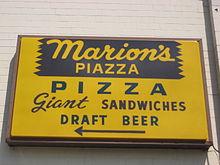
Dayton is home to a variety of pizza chains that have become woven into local culture, the most notable of which are Cassano's and Marion's Piazza. Domino's Pizza chain is test-marketing breakfast pizza in its location close to University of Dayton.
Also based in Dayton is the burrito restaurant chain Hot Head Burritos, which was ranked by AOL.com in 2009 as one of America's next big chains.
Other Dayton-based food chains are Super Subby's, which specializes in submarine sandwiches and chili; the Flying Pizza, which is a New York aestyle pizza chain; Fricker's, which specializes in chicken wings; El Toro, which is a Mexican restaurant chain; and the Submarine House, which specializes in submarine sandwiches. Along with these food chains, Esther Price Candies, a candy and chocolate company, and Mike-sells, the oldest potato chip company in the United States, are also based in Dayton.
Every major religion is represented in Dayton. Christianity is represented in Dayton by dozens of denominations and their respective churches. Notable Dayton churches include the First Lutheran Church, Sacred Heart Church and Ginghamsburg Church. Dayton is also home to the United Theological Seminary, one of thirteen seminaries affiliated with the United Methodist Church. Judaism is represented by Temple Israel.
Tourists visiting Montgomery County accounted for $1.7 billion in business activity in 2007. Tourism also accounts for 1 out of every 14 private sector jobs in the county. Tourism in the Dayton region is led by The National Museum of the United States Air Force at nearby Wright-Patterson Air Force Base. It is the largest and oldest military aviation museum in the world. The museum draws over 1.3 million visitors per year and is one of the single most visited tourist attractions in Ohio.[100][101] The museum houses the National Aviation Hall of Fame.
Other museums also play significant roles in the tourism and economy of the Dayton area. The Dayton Art Institute, a museum of fine arts, owns collections containing more than 20,000 objects spanning 5,000 years of art and archaeological history.[102] The Dayton Art Institute was rated one of the top 10 best art museums in the United States for children.[103] Dayton is also home to a children's museum. The Boonshoft Museum of Discovery is a local children's museum of science with numerous exhibits, one of which includes an indoor zoo with nearly 100 different animals.[104]
Some historical museums also have notability in the region. The Dayton Aviation Heritage National Historical Park, operated by the National Park Service, commemorates the lives and achievements of Dayton natives Orville and Wilbur Wright and Paul Laurence Dunbar. The Wright brothers' famous Wright Flyer III aircraft is housed in a museum at Carillon Historical Park. Dayton is also home to America's Packard Museum with contains many restored historical Packard vehicles.[105] Another notable park, SunWatch Indian Village/Archaeological Park is located on the south end of Dayton. SunWatch is a partially reconstructed 12th-century prehistoric American Indian village; the village is organized around a central plaza dominated by wood posts forming an astronomical calendar. It includes a museum where visitors can learn about the Indian history of the Miami Valley.[106]
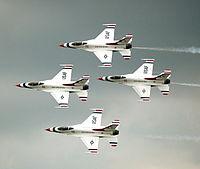
The Vectren Dayton Air Show is an annual air show that takes places at the Dayton International Airport. The Vectren Dayton Airshow is one of the largest air shows in the United States.[107]
The Dayton area is served by Five Rivers MetroParks, encompassing 14,161 acres (5,731 ha) over 23 facilities for year-round recreation, education, and conservation.[108] In cooperation with the Miami Conservancy District, the MetroParks maintains over 70 mi (113 km) miles of paved, multi-use scenic trails that connect Montgomery County with Greene, Miami, Warren and Butler Counties.[109][110] Five Rivers Metroparks, from 1996 to 1998, Dayton hosted the National Folk Festival. Since then, the annual Cityfolk Festival has continued to bring the best in folk, ethnic and world music and arts to Dayton. The Five Rivers MetroParks also owns and operates the PNC Second Street Market located near downtown Dayton. The Market has more than 50 vendors selling items such as produce, cooked foods, baked goods, crafts, and flowers.[111]
The Dayton area hosts several arenas and venues. South of Dayton in Kettering is the Fraze Pavilion, which hosts many nationally and internationally known musicians for concerts. Several notable performances have included the Backstreet Boys, Boston, and Steve Miller Band.[112] South of downtown, on the banks of the Great Miami River, is the University of Dayton Arena, home venue for the University of Dayton Flyers basketball teams and the location of various other events and concerts.[113] UD Arena also hosts the Winter Guard International championships, at which hundreds of percussion and color guard ensembles compete from around the world.[114] North of Dayton is the Hara Arena that frequently hosts expo events and concerts. In addition, the Dayton Amateur Radio Association hosts the annual Dayton Hamvention, North America's largest hamfest, at Hara Arena. Up to 25,000 amateur radio operators attend this convention. The Nutter Center, which is just east of Dayton in the suburb of Fairborn, is the home arena for athletics of Wright State University and the former Dayton Bombers hockey team. This venue is used for many concerts, community events, and various national traveling shows and performances.[115]
Located in the nearby suburb of Moraine is an outdoor water park known as Splash Moraine. The park is best known for its large wave pool.[116]
The Oregon District is a historic residential and commercial district in southeast downtown Dayton. The district is populated with art galleries, specialty shops, pubs, nightclubs, and coffee houses.[117]
The City of Dayton is also host to yearly festivals. Most notably the Dayton Celtic Festival and the City Folk Festival. The Dayton Celtic Festival attracts more than 30,000 people yearly and has Irish dancing, food, crafts, and performers such as Gaelic Storm.[118] Other festivals held in the city of Dayton include, the Dayton Blues Festival, Dayton Music Fest, Urban Nights, the African American and Cultural Festival, and the Dayton Reggae Fest.[119][120][121][122]
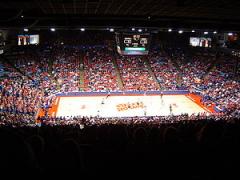

Dayton is served in print by The Dayton Daily News, the city's sole remaining daily newspaper. The Dayton Daily News is owned by Cox Enterprises. As well as the daily print, the Dayton region's main business newspaper is the Dayton Business Journal. Nielsen Media Research ranked the 11-county Dayton television market as the #62 market in the United States.[132] The market is served by stations affiliated with major American networks including: WKEF, Channel 22 ae ABC, operated by Sinclair Broadcasting, WHIO-TV, Channel 7 ae CBS, operated by Cox Communications, WPTD, Channel 16 ae PBS, operated by ThinkTV, which also operates WPTO, assigned to Oxford, Ohio, WDTN, Channel 2 ae NBC, operated by LIN TV, WBDT, Channel 26 ae The CW, operated by Acme Television, and WRGT-TV, Channel 45 ae Fox/My Network TV, operated under a local marketing agreement by Sinclair Broadcasting. The nationally syndicated morning talk show The Daily Buzz originated from WBDT-TV, the Acme property in Miamisburg, Ohio, before moving to its current home in Florida. Dayton is also served by 42 AM and FM radio stations directly, and numerous other stations are heard from elsewhere in Southwest Ohio, which serve outlying suburbs and adjoining counties.[133]
The Greater Dayton Regional Transit Authority (RTA) operates public bus routes in the Dayton metro area. In addition to routes covered by traditional diesel-powered buses, RTA has a number of electric trolley bus routes. The Dayton trolleybus system is the second longest-running of the five remaining trolleybus systems in the U.S., having entered service in 1933.[134] It is the present manifestation of an electric transit service that has been operated continuously in Dayton since 1888.
Dayton operates a Greyhound Station which provides inter-city bus transportation to and from Dayton. The hub is located in the Greater Dayton Regional Transit Authority North-West hub in Trotwood, Ohio.[135]
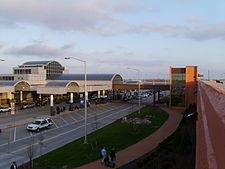
Air transportation is available just north of Dayton proper via the Dayton International Airport. The airport operates 24 hours a day, seven days a week, and offers service to 21 markets through 10 airlines. In 2008, it served 2.9 million passengers. The Dayton International Airport is also a significant regional air freight hub hosting FedEx Express, UPS Airlines, United States Postal Service, and major commercial freight carriers.[136]
The Dayton area also has several regional airports. The Dayton-Wright Brothers Airport is a general aviation airport owned by the City of Dayton located 10 miles (16 km) south of the central business district of Dayton on Springboro Pike in Miami Township. It serves as the reliever airport for Dayton International Airport. The airport primarily serves corporate and personal aircraft users.[137] The Dahio Trotwood Airport, also known as Dayton-New Lebanon Airport, is a privately owned, public-use airport located 7 miles (11 km) west of the central business district of Dayton.[138] The Moraine Airpark is a privately owned, public-use airport situated 4 miles (6.4 km) southwest of the city of Dayton.[139]
The Dayton region is primarily served by three interstates:
Other major routes for the region include:
The Ohio Department of Transportation is currently in the process of $533 million of construction to modify and reconstruct I-75 through downtown Dayton. ODOT is upgrading and widening I-75 from Edwin C Moses Blvd. to Stanley Avenue.[141]
Dayton hosts several inter-modal freight railroad terminals. Two Class I railroads both CSX and Norfolk Southern Railway, operate switching yards in the city.[142]
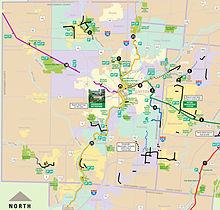
In cooperation with the Miami Conservancy District, Five Rivers MetroParks maintains over 70 mi (113 km) miles of paved, off-road, multi-use scenic trails that connect Montgomery County with over 270 mi (435 km) of trails in Greene, Miami, Warren and Butler Counties.[109][110] The contiguous bike trail system extends as far east as southwest Columbus and as far south as the Ohio River just east of Cincinnati.
The League of American Bicyclists named Dayton as one of only two major cities in Ohio to be "bicycle-friendly".[144] Dayton has also implemented "bike only" lanes downtown.[145]
The Dayton Public Schools operates 34 schools that serve 16,855 students,[146] including:
The city of Dayton has 35 private schools located within the city.[147]
Dayton has 33 charter schools.[148]
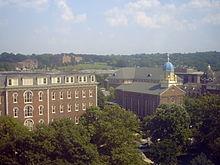
Dayton is home to two major universities: First, the University of Dayton, a private, Catholic institution founded in 1850 by the Marianist order which has the only American Bar Association (ABA) approved law school in the Dayton area.[149] The University of Dayton is also Ohio's largest private university and is one of the top 10 Catholic universities in the United States. UD is also home to the University of Dayton Research Institute which ranks second in the nation for sponsored research,[150] and the Center for Tissue Regeneration and Engineering at Dayton which focuses on human tissue regeneration.[151]
Second, the public Wright State University, which became a state university in 1967. Wright State University established the National Center for Medical Readiness, a national training program for disaster preparedness and relief. The Boonshoft School of Medicine at Wright State University is the only medical school in the Dayton area and is a leader in biomedical research.[152]
Dayton is also home to Sinclair Community College the largest community college at a single location in Ohio [153] and one of the largest community colleges in the nation.[154] Sinclair is acclaimed as one of the country's best community colleges.[155] Sinclair was originally founded as the YMCA college in 1887. Dayton is also home to Miami-Jacob's College, the International School of Broadcasting, and the Dayton School of Medical Massage. Other schools just outside of Dayton that shape the educational landscape are Kettering College of Medical Arts in Kettering, DeVry University in Beavercreek (Dayton), and Clark State Community College in Springfield. Just outside of Dayton proper is the public Air Force Institute of Technology, which was founded in 1919 and serves as a graduate school for the United States Air Force. The Air Force Institute of Technology is located at the nearby Wright Patterson Airforce Base.
The Dayton area was ranked the 10th best metropolitan area in the United States for higher education by Forbes.[156]
Dayton has experienced an improving public safety environment since 2003, with crime declining in key categories according to FBI Uniform Crime Reports and Dayton Police Department data.[157] City officials reported in January 2008 a decline of 6.1 percent in crime for 2007 when compared to 2006. From 2003 to 2007, crime decreased by 10.7 percent. Among violent crimes (homicide, rape, robbery and aggravated assault), Dayton saw a decline of 17.3 percent over the five years ending December 31, 2007. Targeted crimes in Dayton declined 39 percent over the five-year period.[158] In 2009, crime continued to fall in the city of Dayton. Crime in the categories of forcible rape, aggravated assault, property crime, motor vehicle theft, robbery, burglary, theft and arson all showed declines for 2009. Overall, crime in Dayton dropped 40 percent over the previous year.[159]
A new police chief, Richard S. Biehl, joined the Dayton Police Department in January 2008. Biehl brought more than 25 years of law enforcement experience (with expertise in prevention and community policing) to Dayton following a career with the Cincinnati Police Department and the Community Police Partnering Center (where he served as Executive Director), also in Cincinnati.
Also notable, John Dillinger a famous bank robber during the early 1930s, was at one time captured and arrested by Dayton city police while visiting his girlfriend at a high-class boarding house in downtown Dayton.[160][161]
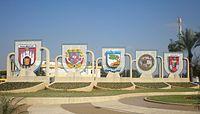
Dayton has five sister cities, as designated by Sister Cities International:
Word Count: 6998







